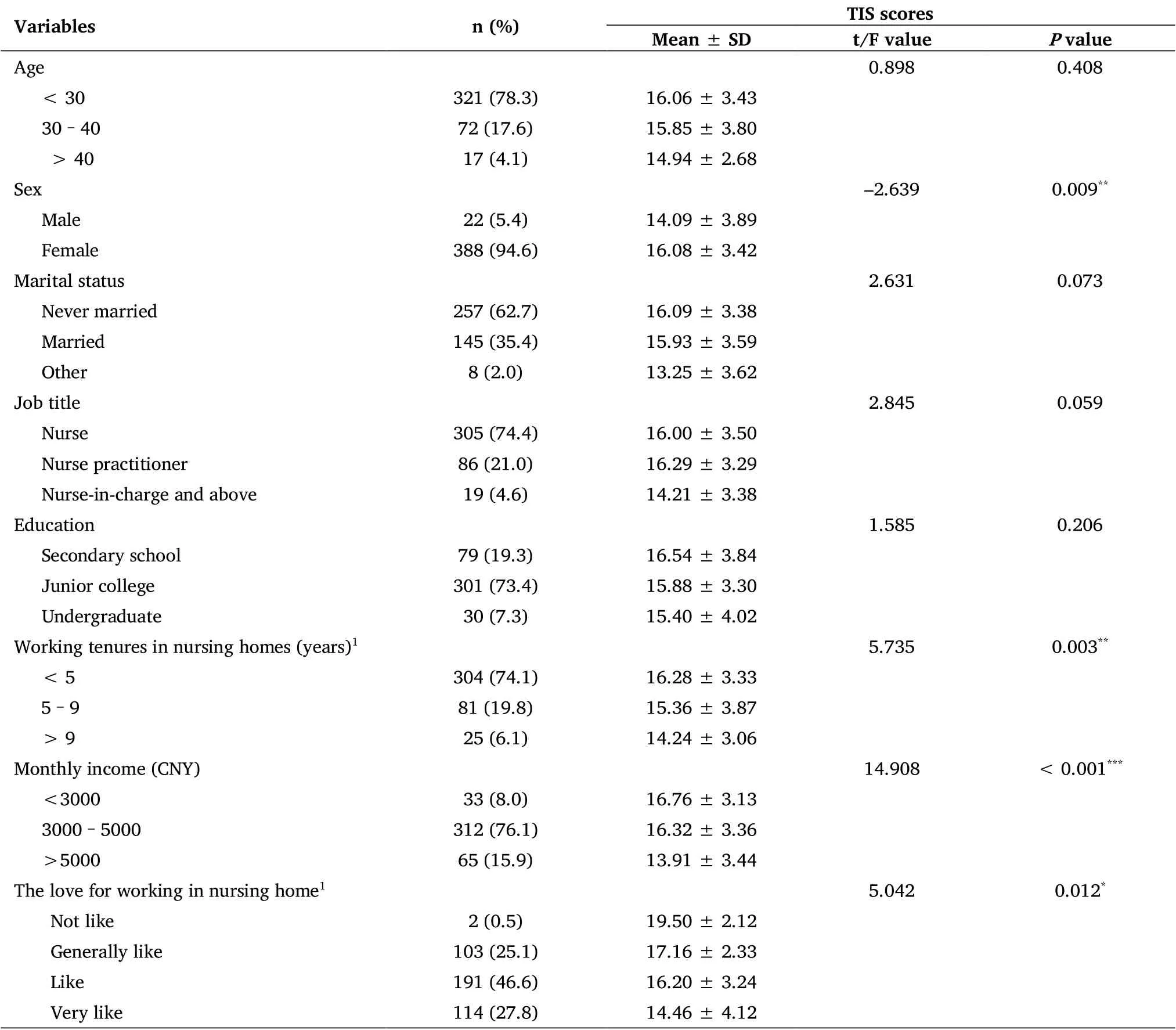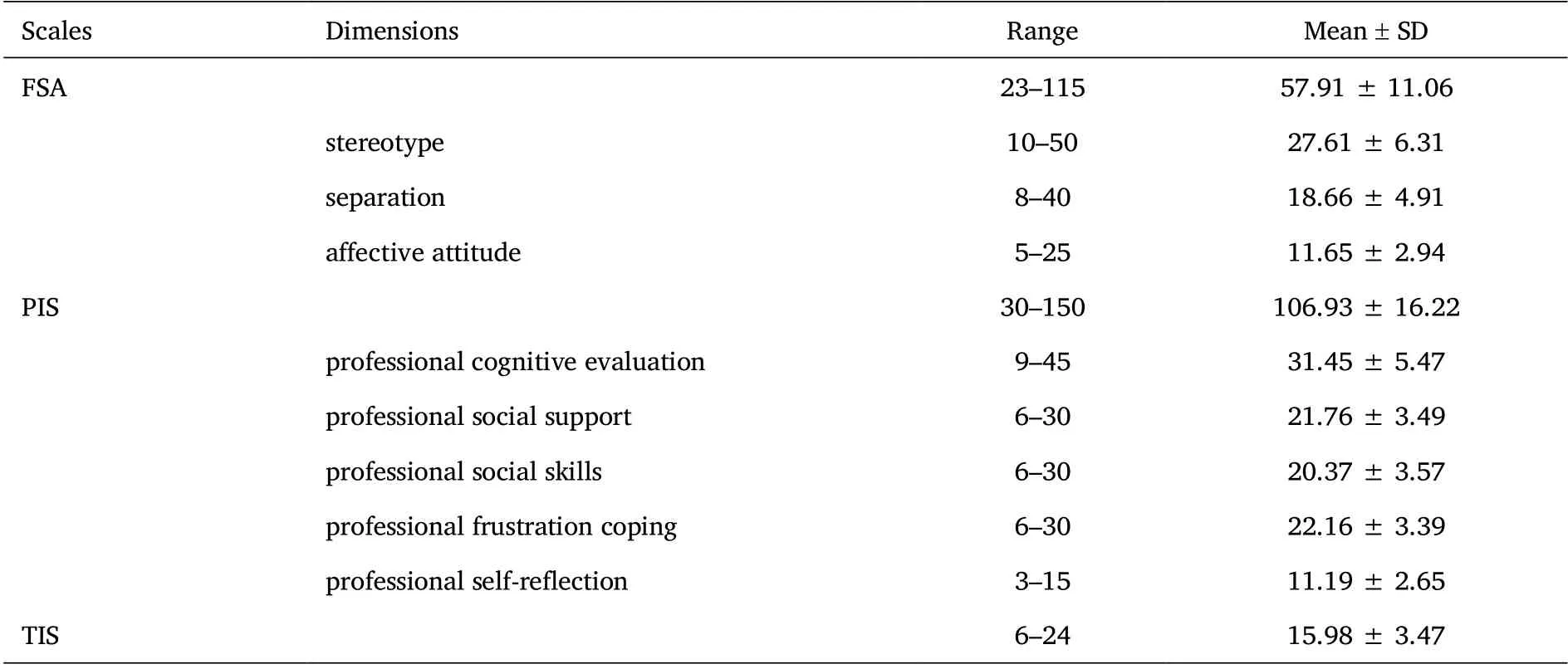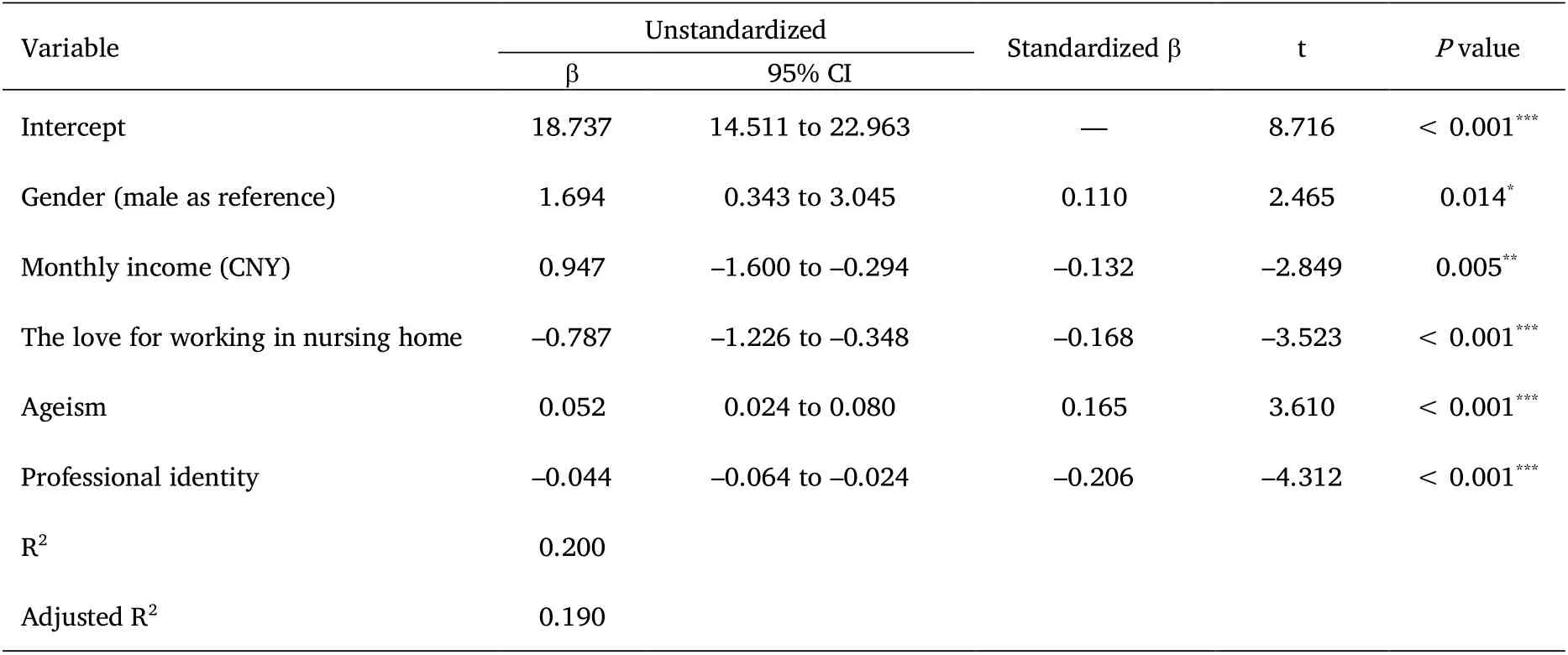The influence of professional identity and ageism on turnover intention in nursing homes: a cross-sectional study from suzhou, China
2022-02-15JiaWeiFanYingWangYuYuWangHaiFangWangLanXuMeiNiuRuLanYinXiaoQingShi
Jia-Wei Fan, Ying Wang, Yu-Yu Wang, Hai-Fang Wang, Lan Xu, Mei-E Niu, Ru-Lan Yin, Xiao-Qing Shi*
1School of Nursing, Department of medicine of Soochow University, Suzhou 215000, China. 2Department of Nursing, The First Affiliated Hospital of Soochow University, Suzhou 215000, China. 3Department of Rheumatology, The First Affiliated Hospital of Soochow University, Suzhou 215006, China.
Abstract Purpose: The aim of this study is to evaluate the influence of professional identity and ageism on turnover intention of nurses employed in nursing homes. Methods: From April to May 2019, a cross‐sectional study was designed to investigate 410 nurses in nursing homes by random cluster sampling using a questionnaire. Descriptive analyses, t‐tests, one‐way ANOVA, Pearson’s correlation and multiple regression were performed for data analyses.Results: The scores of ageism, professional identity and turnover intention were 57.91 ±11.06, 106.93 ± 16.22 and 15.98 ± 3.47. Ageism was a positive predictor with turnover intention and professional identity was a negative predictor of turnover intention. Female,monthly income and the love for working in nursing homes impacted the turnover intention.Conclusions: Cultivating nurses’ professional identity and reduce the ageism of nurses towards the elderly can reduce turnover intention.
Keywords: nursing homes; personnel turnover; intention; professionalism; ageism
Introduction
With the accelerating of global population aging, China, the biggest developing country in the world, is also facing a severe challenge of this problem. According to the statistics from Ministry of Civil Affairs of the People's Republic of China (2018), the number of the old adults(aged 60 and over) had reached 249 million, accounting for 17.9% of the total population [1]. By 2050, this number is estimated to exceed 450 million, representing 33% of the total population [2]. A large aging population leads to an increase in demand for caring services and healthcare professionals. However, previous studies have consistently reported an extreme shortage of workforce at all levels in nursing homes, including caregivers, nurses and other medical professionals [3–5]. The existing human resources of nursing homes is unable to meet the caring needs for the aged people. What's worse, the high turnover rate of nurses, as a global phenomenon, brings greater difficulties to care the old adults [6–8]. A high turnover rate can not only increase the recruitment and training costs of nurses to organizations. but also increases the workload of on‐the‐job nurses and damage the improvement of overall nursing quality, which formed a vicious circle and eventually harm to quality and stability of social services on supporting the aged people [7].
Turnover intention, defined as the possibility that an individual voluntarily leaves his or her job in the period ahead [9], is one of the strongest predictors of actual turnover [10, 11]. Therefore, timely evaluation of nurses' intention to leave is very important to help managers understanding why they abandon their jobs and then take measures. Factors such as gender, age, working time and professional identity that affect turnover intention have been studied by many researchers [9, 12, 13]. Professional identity of nurses refers to the nurses' own views and emotions on the nursing profession, has been reported as a significant factor influencing nurses’ turnover intention[14]. It is also a positive and dynamic index to evaluate the individual's career development and a psychological basis for people to achieve their career [9, 15]. Cowin et al. [16] indicated nurses’professional identity had a stronger relationship with nurses’ retention plans. A study that investigated 2,122 nurses in Turkey demonstrated the negative and significant effect of professional identity on turnover intention among nurses in hospital, in other words, nurses with low professional identity were more likely to leave their jobs than other nurses [14]. A research made in China among township health inspectors also showed the similar results, however, it was worth noting that professional identity had an indirect negative effect on turnover intention through the mediating effect in this study [9]. Few of existing studies of professional identity focus on nurses in nursing homes.
Previous studies have reported that ageism described as prejudice was negatively associated with the intention to work with and care for the aged [17–20]. Ageism in nursing is usually defined as the stereotype and discrimination by nurses against the old adults due to their age [21]. It is considered as a factor of poor nursing quality offered to old people, such as reducing older adults’ abilities of independence and decision‐making [22–24]. Nurses, a component of healthcare professionals, are particularly vulnerable to ageist stereotyping because they are more exposed to old people who are sick and infirm [25, 26]. A systematic review demonstrated positive attitudes of registered nurses towards older people may had been a slight decrease over time [27]. Nevertheless, in Chinese nursing homes, little studies have reported the degree of ageism and the relationship between ageism and turnover intention so far.
Based on the evidences from researches above, our study linked the relationships among professional identity, ageism and turnover intention to evaluate the influence of professional identity and ageism on turnover intention.
Methods
Design
A cross‐sectional study was conducted from April to May 2019 in Suzhou, Jiangsu Province of China.
Participants
Adopting the random cluster sampling method, there were 51 nursing homes doing business in Suzhou, we numbered them and randomly selected 25% (13 nursing homes) by using a table of random numbers.Full‐time nurses who agreed to attend our study were investigated.Exclusion criteria were (1) Interns, (2) refresher nurses, (3) nurses who were not on duty due to illness, maternity leave and other reasons. Permission to conduct the study was acquired from the managers of the nursing departments of nursing homes concerned.The investigators trained by two researchers. The participants were asked to anonymously fill out a written questionnaire. The investigators held responsible for explaining the purpose of the study,reminding the participants of the matters to pay attention to in filling out the questionnaire.
Ethical approval
This survey was approved by the Ethics Committee of The First Affiliated Hospital of Soochow University (IRB No.2018188), All participants were informed written consent, Besides, participants were assured that their answers were anonymous.
Data collection
A structured questionnaire, designed for data collection, comprised four parts including covariates, turnover intention, professional identity and ageism.
Covariate
Socio‐demographic characteristics were age, gender, marital status and educational level. Job‐related questions involved job title,working tenures in nursing homes, monthly income. Another information was investigated on the love for working in the nursing home (not like /generally like / like/very like).
Turnover intention
The turnover intention scale (TIS), which we have been used to measure the turnover intention of nurses, the dependent variable in this study, was developed by Michael and colleagues [28] and then revised by Lee et al. [29] for use in Chinese population. This scale consisted of six items, each item was rated on a four‐point scale with responses (1 = never, 2 = seldom, 3 = occasionally and 4 = often).A total score was counted by the sum of scores for each item and was 6–24, with a high score reflecting a high level of turnover intention.Generally speaking, a total score lower than 12 illustrated a low level turnover intention, 12–17 meant a middle level and more than 17 indicated a high level. We defined a middle and high level of scores as having turnover intention. Our study showed the Cronbach’s alpha coefficient of TIS was 0.751.
Professional identity
The professional identity scale (PIS) designed specifically for nurses,was developed in China by Liu et al. [30]. PIS comprised 30 items covering five dimensions, including professional cognitive evaluation(9 items), professional social support (6 items), professional social skills (6 items), professional frustration coping (6 items) and professional self‐reflection (3 items). A five‐point Likert scale ranged from 1 to 5 representing highly disagree to highly agree to evaluate all these items. The total score was 30–150, with the higher score suggesting higher the level of professional identity of the nurse.Generally, the total score of the scale lower than 60 meant a low level of professional identity, 91–120 meant a middle level and higher than 120 indicated a high level. In this study, the Cronbach’s alpha coefficient of PIS was 0.944.
Ageism
Fraboni Scale of Ageism (FSA) was designed by Fraboni et al. [31] and then revised by Rupp et al. [32] to measure individual’s affection and cognition toward the elderly in a multidimensional manner. which was widely used all over the world. FSA contained 23 items and 3 dimensions involving stereotype (10 items), separation (8 items) and affective attitude (5 items). Each item was graded on a five‐point Likert scale, ranging from 1 (strongly disagree) to 5 (strongly agree),thus, the total score was 23–115. The higher the score, the greater the level of ageism against older adults. The Cronbach’s alpha coefficient was 0.892 in our study.
Data analyses
The data were entered into an Excel database by two trained researchers after all the surveys were completed with removing the invalid questionnaires to ensure accuracy and quality. SPSS software(version 21.0) was used for data analysis. Data normal distributions and homogeneity of variance were visually assessed by means of the Q‐Q plots and Levene test, respectively. Nurses’ characteristics were described by number (n) and percentages (%). One‐way analysis of variance (ANOVA) and independent samplet‐tests were performed to determine significant differences in scores across different groups. If variances were not homogeneous, the Welch test was used. Pearsons correlation coefficients were calculated to assess the linear correlation among all dimensions of the three scales. Multivariable linear regression model was used to examine the associations of the independent and dependent variables. We adopted the stepwise regression that a variable which made significant differences on turnover intention would enter the model with a P value under 0.05 and removed with a P value greater than 0.10. All unordered classified variables in this model were set as dummy variable (for example,never married = 0.0.0, married = 1.0.0, other = 0.0.1) and all ordered classified variables were assigned numbers (for example, not like = 1, generally like = 2, like = 3, very like = 4). In all analyses,the significance level was set atPvalue < 0.05.
Results
A total of 428 questionnaires were collected and 18 surveys were deleted because the fillings were improper or missing data.
Characteristics of participations
Table 1 indicates all of the characteristics of 410 respondents. There were 22 males and 388 females, aged from 18 to 58 (26.97 ± 6.19)years. 62.7% of the participants had never been married. The majority of them graduated from junior college (73.4%) and only 7.3%possessed bachelor’s degrees. A few respondents (21.0%) had the job title of nurse practitioner and less had nurse‐in‐charge or above(4.6%). 74.1% of subjects worked in nursing homes for less than 5 years. 76.1% of participants reported their monthly income reached 3,000–5,000 CNY. A quarter of the respondents (25.1%) reported generally liked working in nursing home and nearly a half (46.6%)reported they liked.

Table 1 differences in TIS among different characteristics of nurses (n = 410)
The scores of FSA, PIS and TIS
The scores of FSA, PIS and TIS as well as their dimensions are showed in Table 2. In general, the ageism, professional identity and turnover intention was 57.91 ± 11.06, 106.93 ± 16.22 and 15.98 ± 3.47. The turnover intention level of nurses was shown in Table 3, 51% of the respondents had moderate turnover intention, 38.3% of the nurses in nursing homes had a high level.
Differences in TIS among different characteristics of nurses
Significant differences on turnover intention (P< 0.05) were observed with respect to sex, working tenures in nursing homes,monthly income, and the love for working in nursing home, which are represent in Table 1.
Pearson’s correlations of TIS with FSA and PIS
Pearson’s correlations show statistically significant associations of turnover intention with ageism and professional identity. Turnover intention had a positive correlation with participants’ ageism (r =0.239,P< 0.001), meanwhile, was negatively correlated with samples’ professional identity (r = –0.320,P< 0.001). Besides,professional identity was negatively correlated with ageism (r = –0.195,P< 0.001).
Multivariable linear regression analyses of factors affecting turnover intention of nurses
Table 4 represents the results of multivariate linear regression model for analysis of factors related to turnover intention. Five variables were significant predictors of turnover intention. R2and adjusted R2were 0.200 and 0.190, respectively. Monthly income, the love for working in nursing home and professional identity had a negative effect towards turnover intention. Those who were female or had higher ageism tended to have higher turnover intention.

Table 2 The scores of FSA, PIS and TIS (n = 410)

Table 3 The turnover intention level of nurses

Table 4 Multivariate linear regression analysis of factors related to turnover intention
Discussion
To our knowledge, there were few cross‐sectional studies on turnover intention of nurses in Chinese mainland nursing homes and few published date about the effect of professional identity and ageism towards turnover intention. Our study found that ageism had a positive correlation with turnover intention and professional identity had a negative effect towards turnover intention. Gender, monthly income and the love for working in nursing homes impacted the turnover intention.
Most of studies assessed turnover intention by a single question and some used different tools. Therefore, we used the percentages of the turnover intentions as a reference to compare different results in different studies [33]. 38.3% participants had high turnover intention.That was higher than nursing home nurses in the United States(29.18%) [34], Taiwan (21.86%) [7] and Turkey (15.5%) [14].Comparing with the nurses in hospital, the turnover intention was also higher. A large‐scale study in 10 European countries investigated 23,159 hospital nurses’ turnover intention which indicated 9%intended to leave their job and this varied from 5% to 17% between countries [35]. In addition, Liu et al. [33] reported 23.9% of nurses in Chinese hospital had a high turnover intention. The turnover intention of nurses in domestic nursing homes was not only higher than that in other countries, but also higher than hospital nurses at home and abroad. The reason may be attributed to three aspects. Because of nursing homes particularity, nurses often have several duties that they not only take the responsibility of medical care, but also meet the needs of life and psychological care, entertainments and rehabilitation guidance for the elderly which increases the workload of nurses. As the construction and development of nursing homes is in its infancy in China, compared with hospitals, its management system still has some imperfections. What’s more, the low social status of nurses induces people over neglect of nursing work that makes nurses dissatisfied.
Our study found that the nurses in nursing homes had a middle level of ageism that meant a neutral attitude towards the old adults. This was higher than previous evidences [26, 27, 36], and there still remained room for reduction. In the regression model, ageism was a predictor of turnover intention. High ageism indicated high turnover intention with an unknown mechanism that need further research.Maybe the reason was that ageism, as a prejudice toward the old adults, would lead to nurses’ dissatisfaction and exclusion while nursing, which may weaken nurses’ enthusiasm in geriatric care and finally result in their intention to leave. Besides, negative attitude can harm to nurses’ ability to assess and manage geriatric syndromes and make them provide poor nursing quality to the aged, for example,they often manage incontinence with containment strategies including diapers and indwelling catheters [37]. Therefore, it is necessary to attach certain attention to ageism of nurses in nursing homes. Rababa et al. [38] reported that the more nurses master relevant knowledge about the elderly, the easier it is to hold a positive attitude towards the elderly. Nursing homes’ managers should also carry out more training related to elderly nursing, so as to improve nurses' elderly health knowledge and reduce their ageism.
A middle level of professional identity of nurses was showed in this study, which was lower than the previous study at abroad [14, 39].According to linear regression analysis, professional identity was negatively related to turnover intention which was consistent with other studies [9, 14]. Professional identity has positive effect on individuals’ positive self‐image, professional satisfaction and sense of belonging [14]. When the individuals have a sense of identity with their professions, the dissatisfaction with their job would reduce a certain extent [40]. Sabanciogullari et al. [14] hold the view that professional identity is the best predictor of retaining nurses. Our study also found professional identity affected turnover intention most. In order to reduce the turnover intention and then reduce actual turnover behavior, cultivating nurses’ professional identity is important.
In the linear regression analysis, gender was correlated with turnover intention, females were more willing to leave than male which was not consistent with the previous studies [8, 41]. Generally speaking, male nurses are particularly not well regarded by the society due to gender stereotypes, which make them have low professional identity and high turnover intention. However, the turnover intention of male nurses was lower than female in our study, this may be attributed to the large gap between the number of male and female surveyed (The data of 22 male were not representative). Besides,monthly income was negative predictors of turnover intention, which supports the previous evidences [42, 43]. The income, which cannot be appropriately matched with skill level, workload and work intensity, is one of the main reasons for high turnover intention [44].The income of most nurses in our study is about 3000‐5000 (CNY),much lower than hospital nurses. Therefore, it is necessary for managers to plan a reasonable workload and establish a reasonable performance appraisal system.
Another independent variable that should be pay attention to was the love for working in nursing homes, which was one of the strong negative predictors of turnover intention in our study. Previous studies indicated poor motivation would lead to high turnover [45]and love for work was an individual level motivator on work [46].Based on these results, it may be claimed that love for work has the negative effect on turnover intention, which is consistent with our study. In order to reduce the high turnover rate of nursing homes,some measures should be taken to cultivate the nurses’ the love for working in nursing homes.
The study explored the effect of professional identity and ageism towards turnover intention. Although, it may contribute new solutions to the high turnover rate of nursing homes, there were several limitations. First were the samples, which were only from one region of China and can limitedly represent the comprehensive situation of nurses in nursing homes. Second, we collected the data through the use of a self‐report questionnaire. Participants may tend to choose socially desirable answers which could induce the idealized responses and influence the outcome of the study. Third, we had difficulties in estimating the potential effect these missing data will have had on the presented results. It is recommended that a large‐sample and multi‐center study should be performed in China and more objective tools could be applied to this study in the future.
Conclusion
Turnover intention of nurses in nursing homes was associated with professional identity, ageism. Hence, in order to intervene the turnover intention of nurses in time and then prevent actual turnover behavior of employed nurses, the government and health system managers can consider taking active and effective measures to cultivate young nurses' professional identity, strengthen the education and guidance of professional value, and help nurses establish a positive attitude towards the elderly to reduce ageism.
杂志排行
Nursing Communications的其它文章
- Delphi and Analytic hierarchy process for the construction of a risk assessment index system for post-stroke shoulder-hand syndrome
- A review of obstacles and facilitating factors of implementing Clinical Ladder Programs in nursing
- Spiritual health, empathy ability and their relationships with spiritual care perceptions among nursing students in China:A cross-sectional correlational study
- Qualitative study on influencing factors of refusal of gastric tube placement in stroke patients with dysphagia
- The relationship of family separation and nutrition status among under-five children: a cross-sectional study in Panti Public Health Center, Jember Regency of East Java, Indonesia
- Nursing cooperation related to thoracoscopic surgery in children
